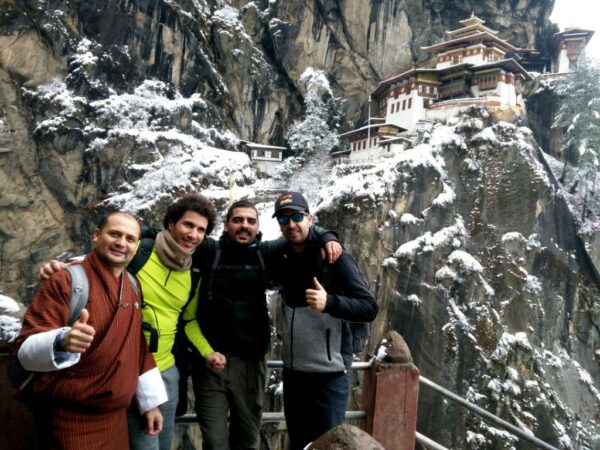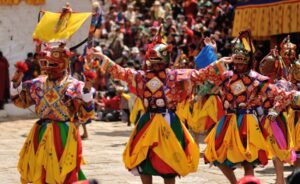8 Days and 7 Nights Western Bhutan adventure.
Duration
Tour Type
Overview
The 8-day Western Bhutan adventure tour includes visits to Thimphu, Punakha, Phobjikha, Haa, and Paro. Highlights include Dochula Pass, Punakha Dzong, and the Black-Necked Crane habitat. Experience the thrilling Chele La Pass ride and hike to the iconic Tiger’s Nest Monastery. Enjoy scenic drives, cultural visits, and local interactions.
Tour Plan
Day 01 Paro - Thimphu:Altitude-2300m/1 hour drive:
During the journey by Druk Air ( Bhutan’s National Airline), one will experience spectacular view of Mt. Everest (of Nepal) and other famous Himalayan peaks, including the revered Mt. Jumolhari and Mt. Jichu Drake of Bhutan. On arrival at Paro International Airport, you will be received by representatives of Indostan Viajes Tours. Drive to Thimph.The distance of about 65kms from Paro airport takes more than 1 hour. Drive south following Pachu River to the river confluence at Chuzom, which is also the hub of road network going to Paro, Ha, Thimphu and Phuntsholing. From Chuzom, the drive takes about less than 1 hour, staying close to the Wangchu River in the valley floor, as you pass through villages and suburbs to the capital, Thimphu. En-route, you can stop to view Tachogang temple.
Thimphu (2,300m): was a wooded farming valley until 1961, when it became Bhutan's official national capital. The massive Tashicho Dzong, about 700 years old, was carefully revamped in the 1960s by the late King Jigme Dorji Wangchuk to house the royal and main government offices. Even today, it still only has a few streets and no traffic lights with estimated population of 150,000 people. On arrival check in hotel and takes a short rest. Later, after lunch visit: Memorial Chorten: This landmark of Thimphu was built in 1974 in the memory of third King, Jigme Dorji Wangchuk, who is popularly regarded as Father of Modern Bhutan. It is a four-storey tall white building, containing statues and iconography of deities from complex tantric teachings and serves as an important place of worship for Thimphu residents, as well as from other parts of the country. Visit Buddha point to take beautiful shot of Buddha and the valley. The big statue of sitting Buddha is located on the hill of Thimphu valley. The statue is made of bronze and the high of the statue is 169ft (51.5m).Before you return back to hotel.Before you return to hotel. Make a short walk in Thimphu city. Before you check in to the hotel. Check your bike. Overnight in hotel.
Day 02: Thimphu – Punakha/Wangduephodrang-Altitude 1250 m/75km/3 hours’ drive.
In the morning you will receive your bike and get to know adventure teams.The ride from Thimphu (75Kms) takes about 2 hours. The road climbs from Thimphu to Dochula Pass (3050m) and descends through ever changing forests into semi-tropical valley of Punakha at around 1250m En-route stop at dochula Pass (3050m) where you can view the eastern Himalayas, including Bhutan’s highest mountain, Gangkhar Punsum (7550m). Visit Punakha or Pungthang Dechen Phodrang "Palace of Great Happiness” is located on the confluence of two rivers, the Pho and Mochu. It was built in 1637 by Shubdrung Nawang Namgyal and following the ancient traditions, it serves as winter residence for chief abbot (Je-khenpo) and the monks of Central Monastic Body, who return to Thimphu in the summer.
Punakha and Wangdue, although two separate districts, are located in one valley (20km or ½ hr drive apart).Make a short ride to parking and visit Chime Lhakhang: a monastery and fertility temple dedicated to Lama Drukpa Kuenley, a Tibetan Buddhist saint known popularly as “the divine madman” and considered a folk hero in Bhutan for his unconventional ways. Drukpa Kuenley originally built a chorten on the site in the 14th century, on which a temple was later built in 15th century. The temple, flanked by nearly 100 tall prayer flags, sits atop a picturesque hill. It has long been a pilgrimage site for childless couples. This easy walk takes about ½ hour each way. Overnight in hotel.
Day 03: Punakha to Phobjikha: Altitude 2700m/70km/3 hours’ drive:
After early breakfast ride to Phobjikha via Wangdue valley. From Wangdue, the road gradually winds up about 2 to 3 hours, almost till Pele La Pass (which divides central from western Bhutan) crosses the Black Mountain. Before reaching to pass the road diverges and we take the road least traveled by. This eventually leads into the beautiful hidden Phobjikha Valley. Phobjikha is part of conservation area with in Black Mountain National Park. It is the winter home of migratory Black Necked Crane. Gangtey is the name of the Monastery that sits on top of a conical hill in the middle of the valley. It is also one of the oldest and largest monasteries in western parts of Bhutan.Ride further south of the valley and make a visit to the Nunnery. On the ways make a visit to farm house to see the people living in rural village. Overnight in hotel.
Day 05-Phobjikha -Haa: Altitude 2200m/140km/5 to 6 hours’ drive.
Ride to Haa via chuzom. The ride will be adventurous, ridding through the beautiful villages. On the way make a short stop to take the picture of Dobji Dzong which was used as a prison in olden day. Continue ride to the valley. Overnight in hotel.
Day 06-Paro-Paro-Altitude 2200m/70km/2 hrs ride.
Ride to paro crossing Chele la pass (3880m) highest memorable road in Bhutan. The road is narrow and windy. Make a short stop on the pass. In clear weather you can see the holey mountain Jomolhari. Start descending to the paro valley. On the way make a short off road ride to the Nunnery which is located on the rock cliff. Continue ride down to the valley stop at the Airport view point. In the evening walk around the town. Overnight in hotel.
Day 07-Paro: Hike to the Tiger-nest:
One of the famous and secret monasteries in Bhutan. Drive to famed Taktsang (Tiger’s lair) monastery. Taktsang monastery is located on the face of a 1,000m seemingly impossible sheer, vertical cliff, above Paro valley. The trail begins near the Satsam (2650m) and climbs steeply uphill to the Cafeteria (2,940m), an area of exposed ridge with panoramic view of Takstang. This takes little more than an hour. (Ponies are provided on request to ride up till this Cafeteria, but rest of way, including return downhill must be on foot.) You can get a good view from the Cafeteria or hike further uphill for another hour or so to the temple itself. There are several other temples and sites within the vicinity. Lunch is served at the tea house. The return trek to the road head is quite steep downhill, where you will be met by the transport. (Stay in hotel or farmhouse).
Day-08-Departure:
After breakfast, transfer to the airport in time for your departure.
Tour Map
Included/Excluded
- 3*hotel twin sharing
- 3 meals(Breakfast, Lunch and dinner)
- English speaking guide
- SDF
- Visa fees
- Transportation with driver
- Entrance fees
- International flight tickets
- Travel insurance
- Personal expenses
- Payment transfer fees
- Tips to service provider
- and any other cost which is not included in given cost
- Additional cost for 4* hotel and above
Frequently asked questions
Bhutan is a year-round destination. There are four seasons: summer (June to August), autumn (September to November), winter (December to February) and spring (March to May). But because of the range of altitudes in the country, and the influence of the north Indian monsoons, the climate is incredibly varied.
In the south, the humid, subtropical climate is fairly consistent year-round, with temperatures between 15oC and 30oC. Central Bhutan, with its temperate forests, has a more seasonal climate, with warm summers and cool, dry winters. The northern regions are much colder during winter. Because of the high altitude, mountain peaks are snowy year-round and the lower reaches remain cool in summer.
In summer, the Indian monsoon season runs from late June or July to late September, mostly affecting the southern regions. Most farming activities take place in the summer, when crops thrive in verdant landscapes.
Autumn, from late September or early October to late November, follows the rainy season. It is characterised by bright, sunny days and some early snowfall at higher elevations. It’s the season of feasts and festivals as farmers reap the fruits of their work.
From late November until March, the crisp, clear and sunny winter sets in, with frost throughout much of the country and snowfall common above elevations of 3,000 metres. The winter northeast monsoon brings gale-force winds at the highest altitudes through high mountain passes, giving Bhutan the name Drukyul, which means Land of the Thunder Dragon in Dzongkha (Bhutan’s national language).
Bhutan’s generally dry spring starts in early March and lasts until mid-April. It is a botanist’s delight, with nature in full bloom. Summer weather commences in mid-April with occasional showers and continues to late June.
Visitors of all nationalities, except those from India, require a visa before entering Bhutan. For all visitors, except those from Bangladesh and the Maldives, this visa must be applied for and approved in advance of travel. Visitors from Bangladesh and the Maldives also require a visa, but this can be applied for and approved either in advance of travel or upon arrival in Bhutan.
Visitors from India are able to apply for a permit but are required to hold an Indian passport or an Indian voter ID card. For Indian nationals under the age of 18, a passport or a birth certificate can be used to enter and they must be accompanied by a legal guardian.
Nationals from Switzerland and Thailand holding diplomatic or government-official passports are eligible for a visa at their port of entry.
A correctly input visa application can take up to five days to process.
The Sustainable Development Fee (SDF) is a daily levy paid by visitors to support Bhutan’s development. Since the kingdom first opened its doors in 1974, guests have played a critical role in our country’s growth.
The SDF is collected by the national exchequer and funds are allocated to various projects that create long-term, sustainable opportunities for the Bhutanese people, through free healthcare, education and training, upskilling the tourism and hospitality industry, improved infrastructure, environmental preservation and conservation, cultural preservation programmes and initiatives that support local businesses and economies. The SDF is also a vital means of maintaining the exceptional forest cover and carbon-neutrality for which our small nation is world-renowned and globally critical. The SDF also helps us to ensure that we can continue to offer guests tranquillity and an intimate experience.
The SDF is USD 100 per night for adults from all countries except for India. Children aged between 6 years and who have not yet turned 12 are eligible to pay USD 50 per night. Children who have not yet turned 6 years old do not have to pay any SDF.
The SDF for Indian nationals (showing a valid Indian passport or Voter ID card) is Nu. 1,200 (or the equivalent amount in Indian rupees) per person, per night. Children aged between 6 years and who have not yet turned 12 are eligible to pay Nu./INR 600 per night. Children who have not yet turned 6 years old do not have to pay any SDF.
















1 Comment
I had a great time in Bhutan! I really recommend a visit to this country if you want to have a great and different experience. I exclusively recommend Indostan Viajes Tours that provided me with this satisfying opportunity. The tour guide was brilliant and I was exposed to the original Bhutan.
Regards,
Comments are closed.